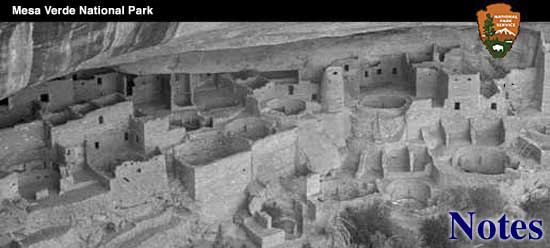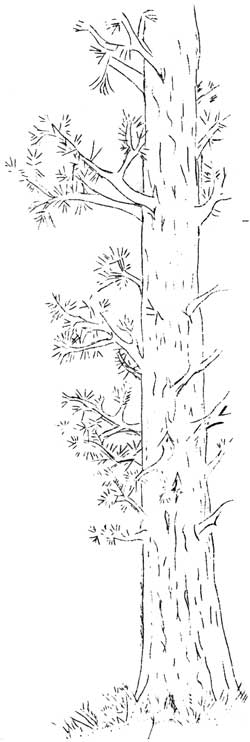

|

"Do you suppose that any of these trees we see growing were here when the cliff dwellers lived in the Mesa Verde?" The visitor who asks this question is usually eying some particularly ancient looking specimen of Pinon or Juniper growing along the trail. He has been told how tree rings used to determine the year that an ancient Pueblo Indian shouldered his stone axe and set out to cut a tree for use in his home. In the broad and narrow rings of the beams our ruins the visitor sees a weather record that tells of fat and lean years, years of plenty and of famine for the people who lived in a far-gone period. While it is improbable that many of the trees now growing here were living when the cliff dwellers occupied their cave homes, a number have been found that have lived through nearly four hundred years of known history. One such specimen is of great interest now because it has a prominent place in the center of the Tree Ring case in the Mesa Verde Museum. The giant Western Yellow Pine (Pinus ponderosa) from which this cross-section was cut, had been growing just across the Mancos River from the park for almost three hundred fifty years. Its rings mark exciting years of history in the making; the years of the conquest of the Southwest by the white man. Standing on a high, rocky mesa, overlooking a stage of unusual beauty, this tree was a mute witness of the drama of the conquest. As one counts the rings he is naturally reminded of the stirring events that took place during the years in which they grew. The white man had already made his first grim bow to the Southwest when, in the year 1585, the young pine took its first flirtatious peek at the sun. Estevancio, the "Black Mexican" of Zuni legend, had met his death at the hands of the people of Hawikuh, one of the seven Zuni villages. Fray Marcos de Niza, thoroughly frightened by the fate of his guide, had hurried back to Mexico with such tales of golden splendor of the villages, that he was afterwards known as the lying monk. In 1542 Coronado's expedition returned to Mexico City, after two years of incredible hardship and adventure, and Nueva Mejica had been made subject to the Spanish King. Our pine was a sturdy youth of fourteen years when, on February 7, 1598, Juan de Onate set out on the first attempt to colonize in the new country. Establishing his headquarters on the Rio Grande, at a place now known as Chamita, he proclaimed himself Governor of Nueva Mejica. In 1609 Pedro de Peralta succeeded Onate as Governor and moved the now prosperous colony to the site of Santa Fe, thus establishing the first permanent settlement in the new province. During its first eighty years of life our pine saw the Pueblo people conquered. On several occasions the Indians attempted to free themselves from the rule of their Spanish conquerors, but without success. In 1680, led by Pope, a San Juan Indian, the Pueblos again revolted. They struck on the tenth of August and there ensued the bloodiest days in the annals of the Southwest. Four hundred colonists and twenty-one missionaries were killed before the Spaniards evacuated Santa Fe and retired to El Paso. Twelve years passed before Don Diego de Vargas succeeded in reentering Santa Fe, and it was not until 1698 that Nueva Mejica was once more in the hands of the Spaniards. For many years the south wind, rustling through the branches of the now venerable pine, whispered little of strife or momentous events. Then, on July 4, 1776, the thirteen English Colonies along the Atlantic seaboard declared their independence from the mother country. A new nation that was someday to take a hand in the Southwest was being born, but "the shot heard round the world" echoed only faintly in the land of Poco Tiempo. In the same year Fathers Dominguez and Escalante left Santa Fe in search of a route that would connect the missions of that region with those of California. According to Escalante's diary of the trip, they camped on the Rio de las Mancos, only a few short miles from the place where our pine tree was growing. In 1804 the youthful United States, turning her attention to the far west, sent Lewis and Clarke overland to the Pacific. Two years later, Lieutenant Zebulon M. Pike, at the head of twenty-three men, was sent across the plains into Colorado. Wandering into Spanish territory he was arrested and taken to Chihuahua. Later he was escorted back to the border, bringing with him the best account of the Spanish Southwest that had been obtained up to that time. Mexico became independent from Spain in 1821 and lifted the ban that Spain had enforced on trade with the United States. This resulted in the establishment of the Santa Fe trail, and marked the beginning of an era of prosperous trading in furs and other goods. It also made possible the establishment of Bent's Fort, and the building of a great system of trading posts and stopping places for the great caravans of immigrants that were coming into the west. Far to the south the people of Texas fought successfully for freedom from Mexico, and established an independent nation on May 14, 1836. After ten years Texas was admitted to the Union of the United States and a short time later a boundary dispute led to the war with Mexico. These difficulties were settled by the treaty of Guadalupe Hidalgo and the purchase by the United States of the territory that now comprises the states of New Mexico, Nevada, Utah, and parts of Colorado and Arizona. Our pine tree had passed into the hands of another nation. In the year 1849, the hills and mesas echoed to the tune of "Oh Susaana," as twenty-five hundred of the "Forty-niners" passed through Santa Fe, lured by the call of gold and adventure in California. All around the two hundred seventy year old pine there was much human activity from the year 1850 until 1861, as the United States explored its new possessions. Many notable expeditions were sent into the field. In 1850-51 Captain Stansbury and his men circled the Great Salt Lake, and two years later Captain J. W. Gunnison explored western Colorado. In 1859 Captain J. N. Macomb and J. S. Newbury circled the Mesa Verde, passing almost within the shadow of our pine. Except for one invasion of New Mexico by the Confederates from Texas, the Southwest took little part in the Civil War. The battle cries of the Navahos disturbed the settlers more than the thundering artillery of the war between the states. The nomadic Indians of the Southwest were taking full advantage of the unsettled conditions of the war years, the Navahos being the worst of all. Finally several thousand of them were captured by Col. Kit Carson in 1864, and taken to Bosque Redondo in southern New Mexico. After being held captive for a couple of years they were returned to their reservation and gave very little trouble after that time. During the last sixty years of its life the aged pine saw the mantle of peace take the place of the bloodshed and intrigue that had been the theme of the play it had watched for three hundred years. The trails blazed by the Conquistadores became highways for pleasure and commerce, and the spade and trowel of the archeologist replaced the musket and sword of the earlier explorers. The discovery of the great cliff dwellings of the Mesa Verde resulted in the passing of the Antiquities Act, June 8, 1908, and the creation of Mesa Verde National Park twenty-one days later. Almost within the shadow of our pine, scientists worked earnestly, uncovering the villages left by a race that had vanished centuries before the tree took root. The end came for our pine in its three hundred thirty-ninth year. During a summer thunderstorm lightening sheared off its top, leaving only the scarred trunk. For a number of years it stood, until finally Mr. Earl Morris, who was excavating nearby, cut it to get the secrets held by its rings. Over three centuries of weather were chronicled there and were of aid in checking the Tree Ring Chronology by which we date our ruins. A section of the tree now occupies a prominent place in the Tree Ring case in our museum. Its wide and narrow rings record the weather it experienced, but, unfortunately, they do not tell of those stirring events that took place during the three centuries of the tree's life. | ||||||
| <<< Previous | > Cover < | Next >>> |
vol7-1f.htm
14-Oct-2011